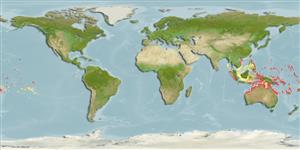Common names from other countries
>
Eupercaria/misc (Various families in series Eupercaria) >
Scaridae (Parrotfishes) > Scarinae
Etymology: Scarus: Greek, skaros = a fish described by anciente writers as a parrot fish; 1601 (Ref. 45335).
More on author: Schultz.
Environment: milieu / climate zone / depth range / distribution range
Ecologia
marinhas associadas(os) a recifes; intervalo de profundidade 2 - 40 m (Ref. 90102), usually 20 - ? m (Ref. 9710). Tropical; 19°N - 24°S
Western Central Pacific: Philippines to the Solomon Islands, north to the Marshall Islands, south to Scott Reef and the Great Barrier Reef. Recently recorded from Tonga (Ref. 53797).
Tamanho / Peso / Idade
Maturity: Lm ? range ? - ? cm
Max length : 40.0 cm TL macho/indeterminado; (Ref. 48636)
Espinhos dorsais (total): 9; Raios dorsais moles (total): 10; Espinhos anais 3; Raios anais moles: 9. Males recognized by the yellow pectoral fins, horizontal green band from tip of snout to above pectoral fin base and large individuals with oval yellow patch on caudal peduncle. Females plain yellowish grey with pale lines along abdominal area (Ref. 48636). Scales large. Median predorsal scales 4; 3 scale rows on cheek, ventral row with 1-2 scales. Truncate caudal fin in initial phase (slightly rounded); slightly lunate in terminal phase. Dental plates nearly covered by lips. Terminal males with 1 or 2 upward-projecting canines posteriorly on lower dental plate and 1 on upper plate. Large initial phase individuals are tan while terminal phase individuals have a distinctive transparent yellowish-tan pectoral fin (Ref. 1602).
Inhabits lagoon and channel reefs, usually deeper 20 m (Ref. 9710). Minimum depth of 2 m reported from Ref. 2689.
Life cycle and mating behavior
Maturidade | Reprodução | Desova | Ovos | Fecundidade | Larvas
Oviparous, distinct pairing during breeding (Ref. 205).
Parenti, P. and J.E. Randall, 2000. An annotated checklist of the species of the labroid fish families Labridae and Scaridae. Ichthyol. Bull. J.L.B. Smith Inst. Ichthyol. (68):1-97. (Ref. 35918)
Categoria na Lista Vermelha da IUCN (Ref. 130435)
CITES (Ref. 128078)
Not Evaluated
Ameaça para o homem
Harmless
Utilização humana
Aquário: Espécies comerciais
Mais informação
ReferênciasAquaculturaPerfil para aquaculturaEstirpesGenéticaElectrophoresesHereditariedadeDoençasProcessamentoMass conversion
ColaboradoresFotografiasStamps, Coins Misc.SonsCiguateraVelocidadeTipo de nataçãoÁrea branquialOutras referênciasCérebrosVisão
Ferramentas
Relatórios especiais
Descarregue XML
Fontes da internet
Estimates based on models
Preferred temperature (Ref.
115969): 25.8 - 28.8, mean 27.4 (based on 28 cells).
Phylogenetic diversity index (Ref.
82804): PD
50 = 0.5000 [Uniqueness, from 0.5 = low to 2.0 = high].
Bayesian length-weight: a=0.02399 (0.01219 - 0.04721), b=3.03 (2.85 - 3.21), in cm Total Length, based on LWR estimates for this species & (Sub)family-body (Ref.
93245).
Nível Trófico (Ref.
69278): 2.0 ±0.00 se; based on food items.
Resiliência (Ref.
120179): Elevada, tempo mínimo de duplicação da população menor que 15 meses (Preliminary K or Fecundity.).
Fishing Vulnerability (Ref.
59153): Low to moderate vulnerability (30 of 100).
